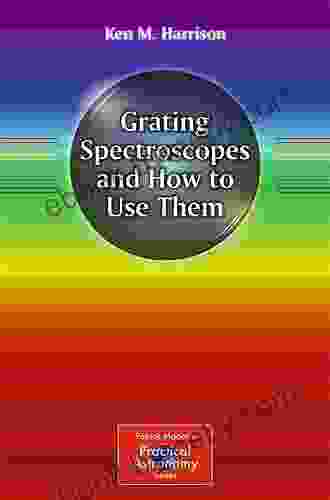Grating Spectroscopes: The Essential Guide for Amateur Astronomers

Grating spectroscopes are a powerful tool for amateur astronomers, allowing them to study the light from stars and other celestial objects in great detail. By splitting the light into its component wavelengths, spectroscopes can reveal information about the object's temperature, composition, and motion.
4.8 out of 5
| Language | : | English |
| File size | : | 8055 KB |
| Text-to-Speech | : | Enabled |
| Screen Reader | : | Supported |
| Enhanced typesetting | : | Enabled |
| Word Wise | : | Enabled |
| Print length | : | 183 pages |
This comprehensive guide will teach you everything you need to know about grating spectroscopes, from choosing the right model to setting it up and interpreting the results. With clear instructions and helpful illustrations, this book will empower you to use this valuable tool to explore the universe like never before.
Chapter 1: What is a Grating Spectroscope?
A grating spectroscope is a device that splits light into its component wavelengths. This is done by passing the light through a grating, which is a thin piece of material with a series of parallel lines or grooves. The grooves in the grating diffract the light, causing it to spread out into a spectrum.
The spectrum of an object can tell us a lot about its composition and properties. For example, the temperature of an object can be determined by the color of its spectrum. Hotter objects emit more blue light, while cooler objects emit more red light.
Chapter 2: Choosing a Grating Spectroscope
There are many different grating spectroscopes on the market, so it is important to choose the right one for your needs. The following factors should be considered when choosing a spectroscope:
- Dispersion: The dispersion of a spectroscope is the amount of spread between the different wavelengths of light. A higher dispersion spectroscope will produce a more detailed spectrum.
- Resolution: The resolution of a spectroscope is the ability to distinguish between two closely spaced wavelengths of light. A higher resolution spectroscope will be able to resolve finer details in the spectrum.
- Aperture: The aperture of a spectroscope is the diameter of the lens or mirror that collects the light. A larger aperture will collect more light, resulting in a brighter spectrum.
- Price: Grating spectroscopes range in price from a few hundred dollars to several thousand dollars. It is important to set a budget before you start shopping.
Chapter 3: Setting Up a Grating Spectroscope
Once you have chosen a grating spectroscope, you need to set it up properly. The following steps will help you get started:
- Attach the spectroscope to your telescope. The spectroscope should be attached to the focuser of your telescope.
- Align the spectroscope. The spectroscope should be aligned so that the slit is perpendicular to the optical axis of the telescope.
- Focus the spectroscope. The spectroscope should be focused so that the spectrum is sharp and clear.
Chapter 4: Interpreting the Results
Once you have set up your grating spectroscope, you can start interpreting the results. The spectrum of an object can tell you a lot about its composition and properties. The following are some of the things that you can learn from a spectrum:
- Temperature: The temperature of an object can be determined by the color of its spectrum. Hotter objects emit more blue light, while cooler objects emit more red light.
- Composition: The composition of an object can be determined by the presence of certain lines in its spectrum. Each element has its own unique set of spectral lines.
- Motion: The motion of an object can be determined by the Doppler shift of its spectral lines. If an object is moving towards us, its spectral lines will be shifted towards the blue end of the spectrum. If an object is moving away from us, its spectral lines will be shifted towards the red end of the spectrum.
Grating spectroscopes are a powerful tool for amateur astronomers, allowing them to study the light from stars and other celestial objects in great detail. This comprehensive guide has provided you with all the information you need to get started with using grating spectroscopes. With clear instructions and helpful illustrations, this book will empower you to use this valuable tool to explore the universe like never before.
So what are you waiting for? Get started today and see what the universe has to offer!
4.8 out of 5
| Language | : | English |
| File size | : | 8055 KB |
| Text-to-Speech | : | Enabled |
| Screen Reader | : | Supported |
| Enhanced typesetting | : | Enabled |
| Word Wise | : | Enabled |
| Print length | : | 183 pages |
Do you want to contribute by writing guest posts on this blog?
Please contact us and send us a resume of previous articles that you have written.
 Book
Book Novel
Novel Page
Page Chapter
Chapter Text
Text Story
Story Genre
Genre Reader
Reader Library
Library Paperback
Paperback E-book
E-book Magazine
Magazine Newspaper
Newspaper Paragraph
Paragraph Sentence
Sentence Bookmark
Bookmark Shelf
Shelf Glossary
Glossary Bibliography
Bibliography Foreword
Foreword Preface
Preface Synopsis
Synopsis Annotation
Annotation Footnote
Footnote Manuscript
Manuscript Scroll
Scroll Codex
Codex Tome
Tome Bestseller
Bestseller Classics
Classics Library card
Library card Narrative
Narrative Biography
Biography Autobiography
Autobiography Memoir
Memoir Reference
Reference Encyclopedia
Encyclopedia Kate Westerlund
Kate Westerlund Karl Evanzz
Karl Evanzz Sally Ozonoff
Sally Ozonoff Justin Roethlingshoefer
Justin Roethlingshoefer Mark Goulston
Mark Goulston Lajoyce Brookshire
Lajoyce Brookshire H G Wells
H G Wells Ken Auletta
Ken Auletta Keith Blenman
Keith Blenman Nellie Carlson
Nellie Carlson Phil Emmert
Phil Emmert Kate Cullen
Kate Cullen Kathryn Mykel
Kathryn Mykel Paul Thurlby
Paul Thurlby Karl F Cohen
Karl F Cohen Kathy A Zahler
Kathy A Zahler Write Blocked
Write Blocked Ross Mccluney
Ross Mccluney Nick Spencer
Nick Spencer Karl Tobien
Karl Tobien
Light bulbAdvertise smarter! Our strategic ad space ensures maximum exposure. Reserve your spot today!

 Michael SimmonsEnter the Heart-Pounding Realm of "Hellion Relentless": A Literary Odyssey...
Michael SimmonsEnter the Heart-Pounding Realm of "Hellion Relentless": A Literary Odyssey...
 Jedidiah HayesThe Real Deal From a Labor and Delivery Nurse On Navigating Your Delivery...
Jedidiah HayesThe Real Deal From a Labor and Delivery Nurse On Navigating Your Delivery... Ken FollettFollow ·15.2k
Ken FollettFollow ·15.2k Colin FosterFollow ·2.4k
Colin FosterFollow ·2.4k Casey BellFollow ·9.2k
Casey BellFollow ·9.2k Marcus BellFollow ·12.7k
Marcus BellFollow ·12.7k Clarence BrooksFollow ·9.2k
Clarence BrooksFollow ·9.2k Alan TurnerFollow ·8.8k
Alan TurnerFollow ·8.8k Herman MitchellFollow ·17.1k
Herman MitchellFollow ·17.1k Giovanni MitchellFollow ·2.4k
Giovanni MitchellFollow ·2.4k

 George Orwell
George OrwellPandemic with Dogs: Two Essays
By Susannah Charleson In the midst of...

 Leo Mitchell
Leo MitchellAdam Smith's The Wealth of Nations: A Classic Treatise on...
Adam Smith's The...

 Cade Simmons
Cade SimmonsUnlock Your Communication Potential: Effective Techniques...
Communication is a fundamental...

 Floyd Richardson
Floyd RichardsonFire and Ashes: Success and Failure in Politics
Fire and Ashes: Success and...

 Oliver Foster
Oliver FosterUnlock the Enchanting Mystery of Ken Follett's "The Key...
Embark on a captivating literary journey into...
4.8 out of 5
| Language | : | English |
| File size | : | 8055 KB |
| Text-to-Speech | : | Enabled |
| Screen Reader | : | Supported |
| Enhanced typesetting | : | Enabled |
| Word Wise | : | Enabled |
| Print length | : | 183 pages |










